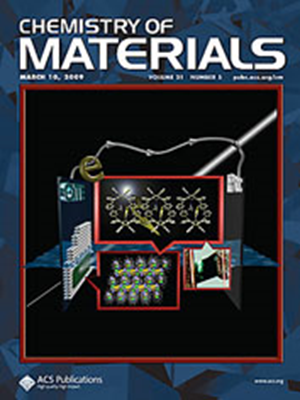Structure–Activity Relationships in Ether-Functionalized Solid-State Metal–Organic Framework Electrolytes
IF 7
2区 材料科学
Q2 CHEMISTRY, PHYSICAL
引用次数: 0
Abstract
The structure–property relationships of metal–organic framework (MOF)-based solid-state electrolytes are not well understood. Herein, a systematic investigation of 12 Zr(IV)-based UiO-66 MOFs with varying ether-chain functional groups was carried out to elucidate the critical microscopic interactions that facilitate improved solid-state electrolyte performance. Enhanced sampling molecular dynamics (MD) simulations were employed and revealed a three-tier ion hopping mechanism: linker–linker hopping, linker-counterion hopping, and counterion-counterion hopping. Detailed structural analysis of the MD trajectories revealed that the chemistry and morphology of the linker groups affect the relative stability and population distribution of the electrolyte components, such that crown-ether-based linker groups enhance the probability of extended, low-barrier ion percolation pathways. As a result, we were able to tune the ionic conductivities by rationally manipulating the counterion distributions, linker binding strengths, and the configurational entropy (multivariability of the linkers). The resulting performance of these MOF-based solid-state electrolytes was significantly enhanced, with a methoxy-functionalized framework (UiO-66-L1100) achieving high ionic conductivities of 2.32 × 10–4 S/cm and 2.07 × 10–3 S/cm at 30 °C and 90 °C, respectively, an order of magnitude greater than other all-solid-state MOF electrolyte systems. The electrolyte stability was evaluated with LiIn|LPSCl|MOF:LiTFSI|LPSCl|LiIn symmetric cells, showing excellent Li plating/stripping processes for over 2 months.

醚功能化固态金属-有机骨架电解质的构效关系
金属-有机骨架(MOF)固态电解质的结构-性能关系尚不清楚。本文对12种具有不同醚链官能团的Zr(IV)基UiO-66 mof进行了系统研究,以阐明促进固态电解质性能改善的关键微观相互作用。采用增强采样分子动力学(MD)模拟,揭示了三层离子跳变机制:连接剂-连接剂跳变、连接剂-反离子跳变和反离子-反离子跳变。MD轨迹的详细结构分析表明,连接基团的化学性质和形态影响电解质组分的相对稳定性和居群分布,因此基于冠醚的连接基团增加了扩展的低势垒离子渗透途径的可能性。因此,我们能够通过合理地操纵反离子分布、连接体结合强度和构型熵(连接体的多可变性)来调整离子电导率。这些基于MOF的固态电解质的性能得到了显著增强,甲氧基功能化框架(UiO-66-L1100)在30°C和90°C时分别达到2.32 × 10-4 S/cm和2.07 × 10-3 S/cm的高离子电导率,比其他全固态MOF电解质体系高出一个数量级。使用LiIn|LPSCl|MOF:LiTFSI|LPSCl|LiIn对称电池对电解质稳定性进行了评估,显示出超过2个月的优异镀/剥离过程。
本文章由计算机程序翻译,如有差异,请以英文原文为准。
求助全文
约1分钟内获得全文
求助全文
来源期刊

Chemistry of Materials
工程技术-材料科学:综合
CiteScore
14.10
自引率
5.80%
发文量
929
审稿时长
1.5 months
期刊介绍:
The journal Chemistry of Materials focuses on publishing original research at the intersection of materials science and chemistry. The studies published in the journal involve chemistry as a prominent component and explore topics such as the design, synthesis, characterization, processing, understanding, and application of functional or potentially functional materials. The journal covers various areas of interest, including inorganic and organic solid-state chemistry, nanomaterials, biomaterials, thin films and polymers, and composite/hybrid materials. The journal particularly seeks papers that highlight the creation or development of innovative materials with novel optical, electrical, magnetic, catalytic, or mechanical properties. It is essential that manuscripts on these topics have a primary focus on the chemistry of materials and represent a significant advancement compared to prior research. Before external reviews are sought, submitted manuscripts undergo a review process by a minimum of two editors to ensure their appropriateness for the journal and the presence of sufficient evidence of a significant advance that will be of broad interest to the materials chemistry community.
 求助内容:
求助内容: 应助结果提醒方式:
应助结果提醒方式:


